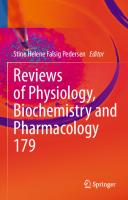Reviews of Physiology, Biochemistry and Pharmacology [177] 3030614948, 9783030614942
Leading researchers are specially invited to provide a complete understanding of a key topic within the multidisciplinar
326 117 4MB
English Pages 150 [155] Year 2021
Table of contents :
Acknowledgements
Contents
The Role of Chemokine Receptors in Renal Fibrosis
1 Introduction
2 CXC Chemokine Receptors
2.1 CXCR1/CXCR2
2.2 CXCR3
2.3 CXCR4
2.4 CXCR6
3 C-C Chemokine Receptors
3.1 CCR1
3.2 CCR2
3.3 CCR7
4 CX3C Chemokine Receptor
4.1 CX3CR1
5 Other Chemokine Receptors
6 Discussion
References
Inflammatory Biomarkers for Cardiovascular Risk Stratification in Familial Hypercholesterolemia
1 Introduction
2 Lipids and Inflammation: A Deadly Combination in FH Patients
3 Inflammatory Biomarkers in FH
4 C-Reactive Protein (CRP)
5 Soluble Adhesion Molecules
6 Cytokines
7 OxLDL
8 Lipoprotein-Associated Phospholipase A2
9 CD16+Monocytes
10 Mean Platelet Volume
11 Neopterin
12 CV Risk Assessment in Patients with FH
13 Conclusion
References
Beyond the Paradigm: Novel Functions of Renin-Producing Cells
1 Background: The Classical View on Renal Renin-Producing Cells (RPC) Within Renin-Angiotensin System (RAS)
2 RPC Beyond RAS
2.1 Progenitor Cell Pool
2.1.1 Nephrogenesis
2.1.2 Adult Kidney
2.2 Neogenesis and Recruitment
2.3 Protection of Renal Microvascular Endothelium
3 Renin Lineage Cells
4 Future Perspectives
References
Role of ASIC1a in Normal and Pathological Synaptic Plasticity
1 Introduction
2 ASIC1a Structure and Location
3 Experimental Tools to Investigate ASIC1a
3.1 Endogenous Modulators
3.2 Polypeptide Toxins
3.3 Chemicals
3.4 ASIC Knockout Mice
4 Role of ASIC1a in Normal Synaptic Plasticity
4.1 Long-Term Potentiation (LTP)
4.2 Long-Term Depression (LTD)
5 Role of ASIC1a in Pathological Synaptic Plasticity
5.1 Alzheimer´s Disease
5.2 Multiple Sclerosis
5.3 Cocaine Addiction
6 Discussion and Conclusion
References
Stationary and Nonstationary Ion and Water Flux Interactions in Kidney Proximal Tubule: Mathematical Analysis of Isosmotic Tra...
1 Introduction
2 Description of the Minimalistic Model
2.1 Functional Organization of Proximal Tubule Epithelium
2.2 Solute Flux Equations
2.3 Water Flux Equations
2.4 Compliant Model and Volumes of Intraepithelial Compartments
2.5 Electrical-Circuit Analysis
2.6 Nomenclature and Sign Conventions
2.7 Numerical Methods
2.8 Choice of Independent Variables
2.9 Geometrical Dimensions and Units of Physical Quantities
3 Results
3.1 General Features
3.2 A Component of Na+ Uptake Bypasses the Pump
3.3 Inhibition of the Na+/K+ Pump
3.4 Effect of Adding Glucose
3.5 Blocking Water Channels of Apical Membrane
3.6 Volume Response of the Epithelium to a Luminal Osmotic Pulse
3.7 Uphill Water Transport and Intraepithelial Water Fluxes
3.8 Isosmotic Transport
4 Discussion
4.1 The Coupling Between Active Sodium Transport and Fluid Uptake
4.2 Eliminating the Osmotic Permeability of Apical Membrane
4.3 Transepithelial Osmotic Permeability Versus Osmotic Permeability of Individual Membranes
4.4 Truly Isosmotic Transport
5 Additional Information
Appendix 1: Nomenclature
Appendix 2: Independent Variables
References
Correction to: Stationary and Nonstationary Ion and Water Flux Interactions in Kidney Proximal Tubule: Mathematical Analysis o...
Correction to: Chapter ``Stationary and Nonstationary Ion and Water Flux Interactions in Kidney Proximal Tubule: Mathematical ...
Acknowledgements
Contents
The Role of Chemokine Receptors in Renal Fibrosis
1 Introduction
2 CXC Chemokine Receptors
2.1 CXCR1/CXCR2
2.2 CXCR3
2.3 CXCR4
2.4 CXCR6
3 C-C Chemokine Receptors
3.1 CCR1
3.2 CCR2
3.3 CCR7
4 CX3C Chemokine Receptor
4.1 CX3CR1
5 Other Chemokine Receptors
6 Discussion
References
Inflammatory Biomarkers for Cardiovascular Risk Stratification in Familial Hypercholesterolemia
1 Introduction
2 Lipids and Inflammation: A Deadly Combination in FH Patients
3 Inflammatory Biomarkers in FH
4 C-Reactive Protein (CRP)
5 Soluble Adhesion Molecules
6 Cytokines
7 OxLDL
8 Lipoprotein-Associated Phospholipase A2
9 CD16+Monocytes
10 Mean Platelet Volume
11 Neopterin
12 CV Risk Assessment in Patients with FH
13 Conclusion
References
Beyond the Paradigm: Novel Functions of Renin-Producing Cells
1 Background: The Classical View on Renal Renin-Producing Cells (RPC) Within Renin-Angiotensin System (RAS)
2 RPC Beyond RAS
2.1 Progenitor Cell Pool
2.1.1 Nephrogenesis
2.1.2 Adult Kidney
2.2 Neogenesis and Recruitment
2.3 Protection of Renal Microvascular Endothelium
3 Renin Lineage Cells
4 Future Perspectives
References
Role of ASIC1a in Normal and Pathological Synaptic Plasticity
1 Introduction
2 ASIC1a Structure and Location
3 Experimental Tools to Investigate ASIC1a
3.1 Endogenous Modulators
3.2 Polypeptide Toxins
3.3 Chemicals
3.4 ASIC Knockout Mice
4 Role of ASIC1a in Normal Synaptic Plasticity
4.1 Long-Term Potentiation (LTP)
4.2 Long-Term Depression (LTD)
5 Role of ASIC1a in Pathological Synaptic Plasticity
5.1 Alzheimer´s Disease
5.2 Multiple Sclerosis
5.3 Cocaine Addiction
6 Discussion and Conclusion
References
Stationary and Nonstationary Ion and Water Flux Interactions in Kidney Proximal Tubule: Mathematical Analysis of Isosmotic Tra...
1 Introduction
2 Description of the Minimalistic Model
2.1 Functional Organization of Proximal Tubule Epithelium
2.2 Solute Flux Equations
2.3 Water Flux Equations
2.4 Compliant Model and Volumes of Intraepithelial Compartments
2.5 Electrical-Circuit Analysis
2.6 Nomenclature and Sign Conventions
2.7 Numerical Methods
2.8 Choice of Independent Variables
2.9 Geometrical Dimensions and Units of Physical Quantities
3 Results
3.1 General Features
3.2 A Component of Na+ Uptake Bypasses the Pump
3.3 Inhibition of the Na+/K+ Pump
3.4 Effect of Adding Glucose
3.5 Blocking Water Channels of Apical Membrane
3.6 Volume Response of the Epithelium to a Luminal Osmotic Pulse
3.7 Uphill Water Transport and Intraepithelial Water Fluxes
3.8 Isosmotic Transport
4 Discussion
4.1 The Coupling Between Active Sodium Transport and Fluid Uptake
4.2 Eliminating the Osmotic Permeability of Apical Membrane
4.3 Transepithelial Osmotic Permeability Versus Osmotic Permeability of Individual Membranes
4.4 Truly Isosmotic Transport
5 Additional Information
Appendix 1: Nomenclature
Appendix 2: Independent Variables
References
Correction to: Stationary and Nonstationary Ion and Water Flux Interactions in Kidney Proximal Tubule: Mathematical Analysis o...
Correction to: Chapter ``Stationary and Nonstationary Ion and Water Flux Interactions in Kidney Proximal Tubule: Mathematical ...
![Reviews of Physiology, Biochemistry and Pharmacology [177]
3030614948, 9783030614942](https://ebin.pub/img/200x200/reviews-of-physiology-biochemistry-and-pharmacology-177-3030614948-9783030614942.jpg)




![Reviews of Physiology, Biochemistry, and Pharmacology Volume 152: Special Issue on Emerging Bacterial Toxins (Reviews of Physiology, Biochemistry, and Pharmacology) [1 ed.]
3540231315, 9783540231318](https://ebin.pub/img/200x200/reviews-of-physiology-biochemistry-and-pharmacology-volume-152-special-issue-on-emerging-bacterial-toxins-reviews-of-physiology-biochemistry-and-pharmacology-1nbsped-3540231315-9783540231318.jpg)
![Reviews of Physiology, Biochemistry and Pharmacology 155 [1 ed.]
3540281924, 9783540281924](https://ebin.pub/img/200x200/reviews-of-physiology-biochemistry-and-pharmacology-155-1nbsped-3540281924-9783540281924-d-6527716.jpg)
![Reviews of Physiology, Biochemistry and Pharmacology 155 [1 ed.]
3540281924, 9783540281924](https://ebin.pub/img/200x200/reviews-of-physiology-biochemistry-and-pharmacology-155-1nbsped-3540281924-9783540281924.jpg)
![Reviews of Physiology, Biochemistry and Pharmacology Vol. 174 [1st ed. 2018]
9783319787749, 9783319787732, 3319787748](https://ebin.pub/img/200x200/reviews-of-physiology-biochemistry-and-pharmacology-vol-174-1st-ed-2018-9783319787749-9783319787732-3319787748.jpg)

